Kansai Paint Bundle
How Did Kansai Paint Become a Global Coatings Giant?
Delve into the Kansai Paint SWOT Analysis and discover the fascinating journey of Kansai Paint, a prominent paint manufacturer that has shaped the global paint industry. From its humble beginnings in Japan, Kansai Paint's story is one of relentless innovation and strategic expansion. Uncover the key milestones and challenges that have propelled this Japanese paint company to the forefront of the coatings market.
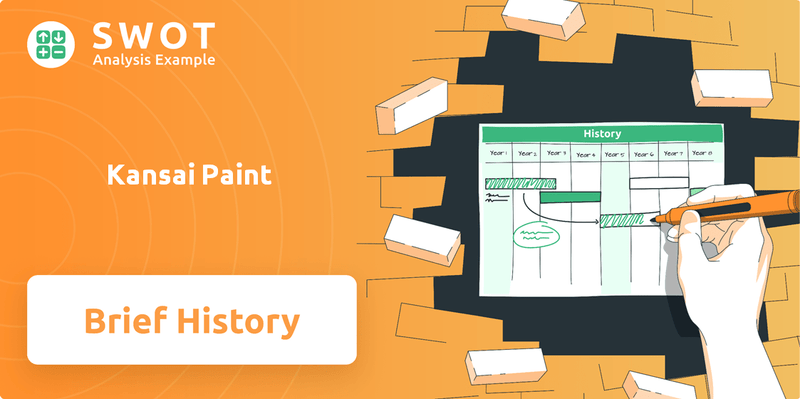
This brief history of Kansai Paint explores its origins in 1918, founded by Katsujiro Iwai with a vision to bolster Japan's industrial base. The company's evolution from a local paint supplier to a global leader is a testament to its commitment to quality and innovation. Learn about Kansai Paint's market share, its impact on the automotive industry and construction, and its significant global presence, making it a crucial player in the paint industry today.
What is the Kansai Paint Founding Story?
The story of the Kansai Paint begins in Japan, rooted in the vision of a man dedicated to his country's industrial advancement. This paint manufacturer has grown from its humble beginnings to become a significant player in the global paint industry.
Kansai Paint history is a narrative of innovation and strategic foresight. The company's foundation was laid on a commitment to create a strong domestic industrial base, reducing Japan's reliance on imports and boosting its economy.
The Kansai Paint company was established on May 17, 1918, in Kanzaki, Amagasaki, Japan. It was founded by Katsujiro Iwai, who initially invested 500,000 yen. Iwai, a merchant from the Kyoto region, was a fervent supporter of Japan's industrial growth. He moved to Osaka around the start of the 20th century and was dedicated to the idea of local industrialization.
Kansai Paint has a rich history marked by significant product launches and strategic decisions. These milestones have shaped the company into the global entity it is today.
- In 1920, the company introduced JAPANITE, and in August 1921, it secured its first patent for a varnish manufacturing method.
- A major breakthrough came in August 1926 with the introduction of CELVA, the first lacquer produced in Japan, which helped establish Kansai Paint in the Japanese market.
- Iwai's founding principles of serenity, responsibility, and innovation continue to guide the company.
The company's initial focus was on producing paints and coatings to support Japan's expanding industries. The introduction of JAPANITE in 1920 was a key early product. This was followed by the registration of the company's first patent in August 1921, which was for a varnish manufacturing method. The introduction of CELVA in August 1926, the first lacquer made in Japan, was a significant achievement. This product helped to establish Kansai Paint as a notable force within the Japanese paint market.
For more insights into the strategic moves that have shaped the company's trajectory, explore the Growth Strategy of Kansai Paint.
Kansai Paint SWOT Analysis
- Complete SWOT Breakdown
- Fully Customizable
- Editable in Excel & Word
- Professional Formatting
- Investor-Ready Format
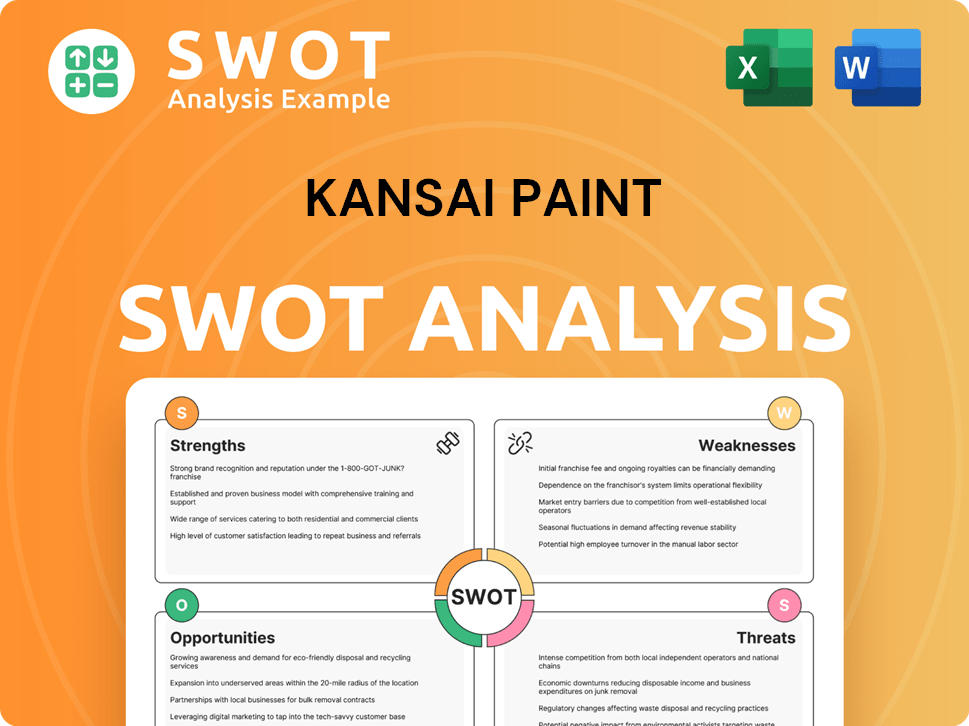
What Drove the Early Growth of Kansai Paint?
The early growth and expansion of the Kansai Paint company marked a significant period of development, even amidst economic challenges in Japan. After establishing itself with products like CELVA, the company broadened its operations. This expansion included entering international markets and boosting its research and development capabilities, which solidified its position as a leader in the paint industry.
In 1933,
International expansion began in 1965 with a joint venture in Singapore. This was followed by entries into Thailand in 1968 and Hong Kong in 1974. These early international ventures set the stage for
A new research and development facility opened in Hiratsuka in 1965, establishing
A key partnership with Nissan Motor Company, formed during this period, provided a crucial foundation for
Kansai Paint PESTLE Analysis
- Covers All 6 PESTLE Categories
- No Research Needed – Save Hours of Work
- Built by Experts, Trusted by Consultants
- Instant Download, Ready to Use
- 100% Editable, Fully Customizable
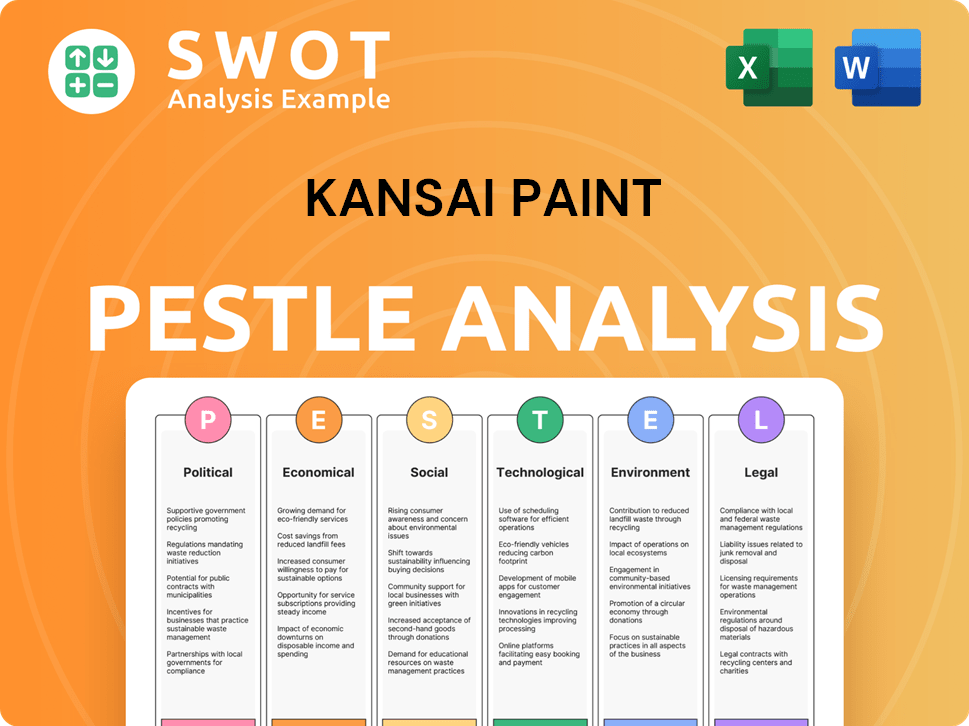
What are the key Milestones in Kansai Paint history?
The Kansai Paint history showcases a journey marked by significant milestones and strategic expansions within the paint industry. The company's evolution reflects its commitment to innovation and adaptability in a dynamic market.
| Year | Milestone |
|---|---|
| 1926 | Developed CELVA, Japan's first lacquer paint. |
| 1974 | Launched ASCA, a water-based, air-drying synthetic resin coating. |
| 1985 | Released Fantac, a marking film. |
| 1986 | Developed Sonne Eduv, a photoresist for printed circuit boards in partnership with Mitsubishi. |
| 2000 | Developed Japan's first waterborne basecoat for automotive refinishing. |
| 2011 | Acquired Freeworld Coatings (now Kansai Plascon Africa Ltd.) in South Africa. |
| 2014 | Introduced ALES Anti-MosQ, a mosquito-repellent paint, in Malaysia. |
Throughout its history,
CELVA, developed in 1926, was a pioneering step as Japan's first lacquer paint, setting an early standard for the
The introduction of ASCA in the early 1970s, commercially launched in 1974, marked a shift towards water-based coatings. This innovation highlighted the company's commitment to environmental considerations and advanced coating technologies.
Fantac, a marking film introduced in 1985, diversified the company's product offerings beyond traditional paints. This expansion into related products demonstrated adaptability and a broader market vision.
The collaboration with Mitsubishi in 1986 to develop Sonne Eduv, a photoresist for printed circuit boards, showcased the company's technological prowess. This partnership expanded its reach into specialized industrial applications.
In 2000, the company developed Japan's first waterborne basecoat for automotive refinishing, which was a significant environmental advancement. This innovation underscored the company's dedication to eco-friendly products.
ALES Anti-MosQ, introduced in 2014 in Malaysia and later approved by the U.S. EPA, was a groundbreaking product. This paint addressed public health concerns, demonstrating the company's commitment to social responsibility.
The
The economic instability of the 1920s and 1930s presented significant challenges for the
The 2008 financial crisis caused global economic shocks, impacting various sectors, including the paint industry. The company responded by accelerating overseas business development and diversifying its markets.
Acquisitions, such as that of Freeworld Coatings in 2011, presented integration challenges. Successfully merging operations and cultures was crucial for maintaining the company's growth trajectory.
In fiscal year 2025, the company faced a 42.9% plunge in net profit attributable to shareholders. This was due to the absence of one-time gains and unexpected costs, highlighting the volatility in the
Exchange rate losses, along with hyperinflation-related impairments in Turkey, impacted operating income. These financial pressures underscored the risks associated with international operations.
Despite challenges, the company showed resilience with strong momentum in India and Africa. These regions contributed to sales and operating profits, demonstrating the success of its global strategy.
Kansai Paint Business Model Canvas
- Complete 9-Block Business Model Canvas
- Effortlessly Communicate Your Business Strategy
- Investor-Ready BMC Format
- 100% Editable and Customizable
- Clear and Structured Layout
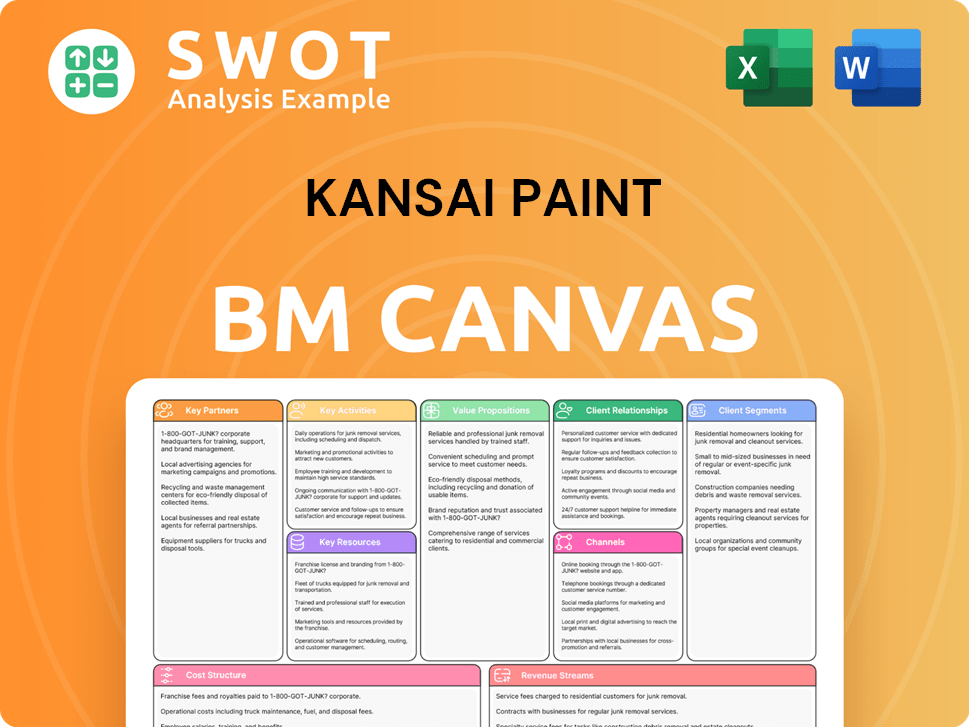
What is the Timeline of Key Events for Kansai Paint?
The Kansai Paint company journey began in 1918, marked by strategic expansions and innovations in the paint industry. From introducing Japan's first lacquer paint to establishing a global presence through acquisitions and partnerships, the company has consistently adapted to market demands and technological advancements. This brief history of Kansai Paint showcases its evolution from a Japanese paint manufacturer to a global player in the paint industry.
| Year | Key Event |
|---|---|
| 1918 | Founded in Amagasaki, Japan, by Katsujiro Iwai. |
| 1926 | Introduced CELVA, Japan's first lacquer paint. |
| 1933 | Expanded with an office and factory opened in Tokyo. |
| 1950 | New headquarters and primary plant opened in Osaka. |
| 1965 | First foreign operation established in Singapore. |
| 1968 | Entered Thailand through a joint venture. |
| 1974 | Established a subsidiary in Hong Kong. |
| 1983 | Technology cooperation partnership with Goodlass Nerolac Paints in India. |
| 1987 | Established Kansai Paint (America), Inc. |
| 1992 | Entered the mainland Chinese market with a production subsidiary in Tianjin. |
| 1999 | Goodlass Nerolac Paints Pvt Ltd (India) became a subsidiary. |
| 2006 | Acquired PAR, a Malaysian brand, leading to the founding of Kansai Coatings Malaysia. |
| 2011 | Acquired shares in Freeworld Coatings (South Africa), now Kansai Plascon Africa Ltd. |
| 2013 | Became the official paint partner of English football club Manchester United. |
| 2014 | Introduced ALES Anti-MosQ, a mosquito-repellent paint, in Malaysia. |
| 2017 | Mr Paint Man joins Kansai Paint family, further expanding Malaysian presence. |
| 2019 | European subsidiary Kansai Helios Coatings GmbH acquires WEILBURGER, an industrial coatings manufacturer. |
The company aims for a revenue target of ¥700 billion (approximately $4.67 billion) by 2027, a significant increase from ¥610 billion in 2024. This growth strategy reflects the company's ambition to strengthen its position in the paint industry.
Kansai Paint projects an increase in EBITDA margin from 14.6% in 2024 to 17.0% by 2027. The adjusted ROE is also targeted to rise from 13% to 15% during the same period, indicating improved financial performance.
Japan is expected to contribute ¥180 billion, with India also at ¥180 billion. Europe is forecasted at ¥190 billion, Asia at ¥80 billion, Africa at ¥59 billion, and North America at ¥11 billion, illustrating the company's diverse market focus.
Key initiatives include a focus on sustainability and eco-friendly products, as well as expansion into untapped markets like Tier 2 and Tier 3 cities in India. These efforts are designed to drive future growth.
Kansai Paint Porter's Five Forces Analysis
- Covers All 5 Competitive Forces in Detail
- Structured for Consultants, Students, and Founders
- 100% Editable in Microsoft Word & Excel
- Instant Digital Download – Use Immediately
- Compatible with Mac & PC – Fully Unlocked
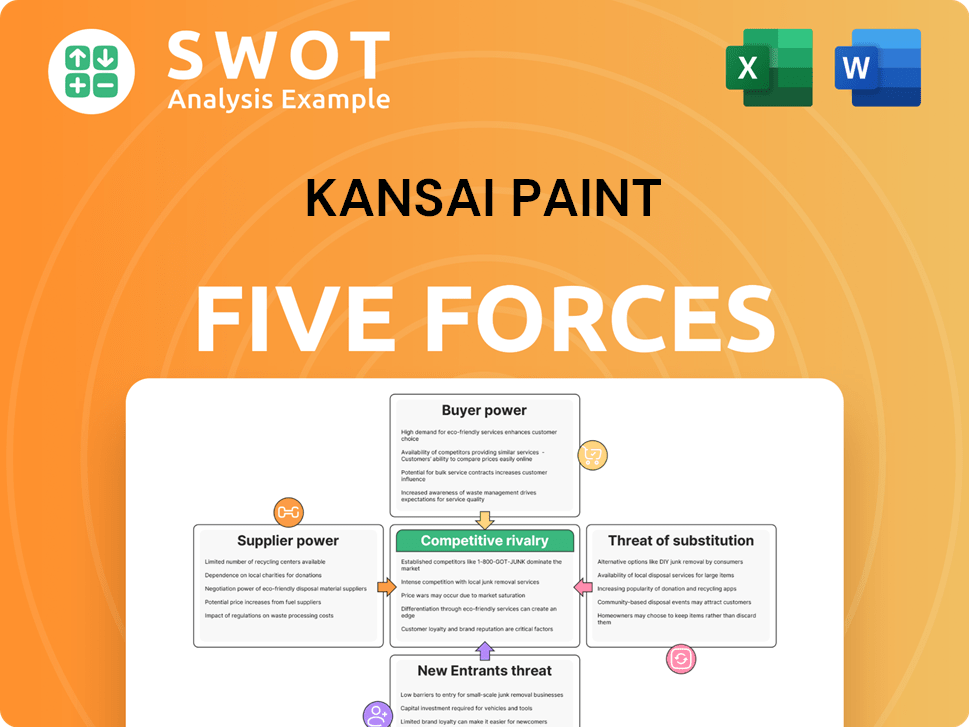
Related Blogs
- What is Competitive Landscape of Kansai Paint Company?
- What is Growth Strategy and Future Prospects of Kansai Paint Company?
- How Does Kansai Paint Company Work?
- What is Sales and Marketing Strategy of Kansai Paint Company?
- What is Brief History of Kansai Paint Company?
- Who Owns Kansai Paint Company?
- What is Customer Demographics and Target Market of Kansai Paint Company?
Disclaimer
All information, articles, and product details provided on this website are for general informational and educational purposes only. We do not claim any ownership over, nor do we intend to infringe upon, any trademarks, copyrights, logos, brand names, or other intellectual property mentioned or depicted on this site. Such intellectual property remains the property of its respective owners, and any references here are made solely for identification or informational purposes, without implying any affiliation, endorsement, or partnership.
We make no representations or warranties, express or implied, regarding the accuracy, completeness, or suitability of any content or products presented. Nothing on this website should be construed as legal, tax, investment, financial, medical, or other professional advice. In addition, no part of this site—including articles or product references—constitutes a solicitation, recommendation, endorsement, advertisement, or offer to buy or sell any securities, franchises, or other financial instruments, particularly in jurisdictions where such activity would be unlawful.
All content is of a general nature and may not address the specific circumstances of any individual or entity. It is not a substitute for professional advice or services. Any actions you take based on the information provided here are strictly at your own risk. You accept full responsibility for any decisions or outcomes arising from your use of this website and agree to release us from any liability in connection with your use of, or reliance upon, the content or products found herein.